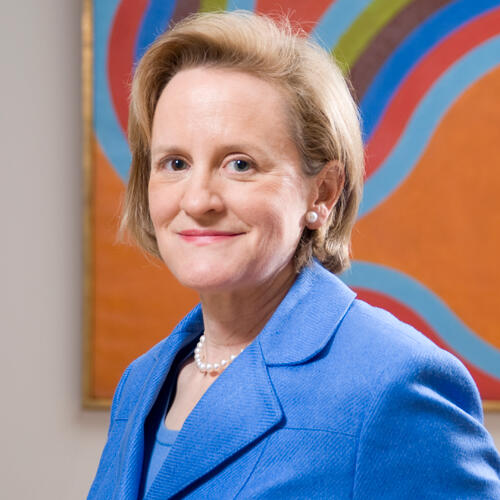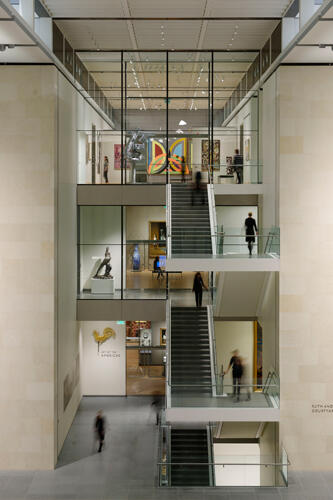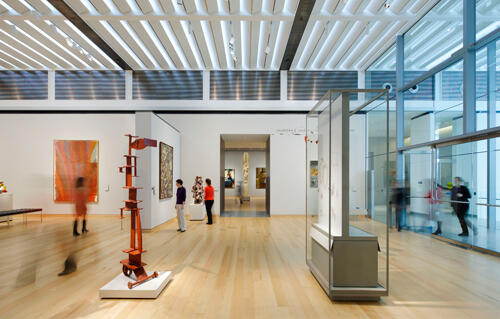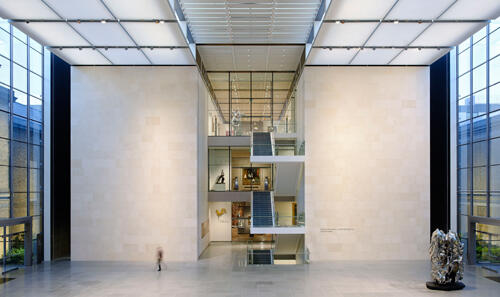Interview: Elliot Bostwick Davis
A Collection of Art of the Americas Spreads its Wings in Boston
The new pavilion of the Museum of Fine Arts Boston, designed by Foster & Partners (London), creates a common space, where artworks from North, Central, and South America produced over the course of three millennia interact like in no other museum. Maya art, Andean textiles, goldwork, wood carvings and furniture, and paintings are showcased as synonymous with or referents of the work of our artists throughout the history of the continent.

Boston, one of themost conservative societies in the United States, is the center of a very progressive vision focused on expanding the knowledge of the arts of the Americas. At the Museum of FineArts Boston, a newwing gathers together examples of the artistic production of the continent over the course of three millennia, confirming the originality of thought and the creative interconnection behind this art like almost no museum has.
“I think all this shows that there is great openness and cutting-edge thinking in Boston, although we may not be a cultural or financial capital like New York,” says Elliot Bostwick Davis, chair of the MFB’s Art of the Americas department. “Museums are the guardians of culture, and we are
demonstrating how to make this one work.”
Designed by Foster & Partner (a firm that was also responsible for the ambitious renovation of the British Museum in London), this pavilion showcases more than five thousand artifacts and works of art. This is the first time that the museum has an adequate space to exhibit this rich legacy, illustrating and deciphering parallels in the artistic expressions of North, Central and South America from Pre- Columbian times to the late 20th century.
Inaugurated in November 2010, fifty-three galleries feature rare pieces in ceramics and exceptional examples of goldwork, textiles and fashion, wood carvings and furniture, sculpture and painting. In September 2011, the Museum will inaugurate a new wing for contemporary art, while the moveable divisions will allow each gallery to adjust the exhibition space to the required dimensions. “In this way, we can continue to rethink our work and our collection.”
A museum connected to the city
As Malcolm Rogers, its director, has written, the Museum of Fine Arts Boston represents the crossroads where art and history meet.This institution is an open book ready to highlight the history of the American Revolution and of Boston as the “cradle of freedom.”
With this new space, its Collection incorporates new wings not only to narrate these historical chapters, but especially to show the world what has happened in America before and after the Conquest.
“Our Collection was more focused on the art of the American colonies, but in 1999 we began to reorganize the museum and arrange the works chronologically and according to geographic areas,” Bostwick Davis explains.The greatest challenge was to structure the collection of the Americas in such a way that it could interact with those other cultural poles such as Ancient Egypt, Greece, Asia, Oceania and Europe. Curators and educators from all the departments are working together to provide coherence to this idea. At the beginning, space was the priority, but that goal was met after an intense fundraising ncampaign that raised more than 500 million dollars. Close to 345 million dollars were invested in the project to renovate the beautiful Beaux Arts building dating from 1909.
The architectural project designed by Norman Foster and his team incorporated not only four floors hosting 53 new galleries but also a glass-enclosed courtyard , a grand public space and relaxation area that links the new wing to the historic Museum building. “The building has been designed for art and its function is that people enjoy art,” Bostwick Davis asserts.
The extensive use of glass expands the physical boundaries of the Museum, in such a way that passers-by may see its interior, and visitors never lose contact with the city.
Pre-Columbian Cultures and Early Colonies
“One of the greatest surprises that this Art of the Americas Wing offers is that people never imagine that the collection of Pre-Columbian art is so important,” Bostwick Davis reveals. Huge funerary urns created by Guatemala’s Maya K’iché may be found at the entrance to the pavilion devoted to Ancient American and Native North American art, where this cultural journey begins.
This space also hosts a magnificent collection of artifacts, statuettes, ceramics, everyday objects and jewelry created by the Olmec and other ancient cultures from Mexico, Guatemala, Belize, El Salvador and Honduras. “That is the basis of the collection we were able to build thanks to some incredible donations, aimed at exploring the level of advancement of the different American civilizations before Columbus’s arrival in the NewWorld.“
The section showcases ornaments in gold and precious stones produced by native peoples from Central and South America such as Colombia’s Tayrona indians. Also on view are musical instruments, amulets and figures used in fertility and war rituals, as well as colorful tapestries made using very complex weaving techniques, which are an example of the flowering of civilization interrupted by the Conquerors.
“There is still much to showcase, but we must be patient because we must strictly check the provenance of the material
we receive as donations.”
Besides, this first level builds bridges linking it to the evolution of the native peoples of the United States and Canada through works that formed part of the Museum’s initial collection in 1876 and others produced in recent times such as paintings, works on paper, basketwork, glass and textiles. Original furniture recreates the domestic atmosphere in typical early 18th century houses in New England, while tools and instruments and ship models explore the traditions of crafts, wood-carving and silverwork in the nascent colonies.
Likewise, a sublime selection of Colonial embroidery reveals the importance of that craft as part of women’s education and
source of income at that time. Regrettably, artwork explanations and credits are found only in English, which greatly restrains access to information to non-Anglophone visitors.
From the Declaration of Independence to the 20th century
The core of this new pavilion is the collection of art produced in the aftermath of the American Revolution, in which John Singleton Copley’s portraits of historical figures such as Paul Revere stand out. Copley’s portrait of Revere is unprecedented, since it explores a facet that is quite different from his role as a hero of American Independence: he is depicted as a craftsman, with the silverwork that he and his father created. Among these objects, the famous silver “Son of Liberty Bowl”, which he made in 1768 and which included the names of the signatories of the Declaration of Independence, is exhibited.
In the “Latin America before 1900” gallery, recent acquisitions such as the portrait of Don Manuel José Rubio y Salinas, Archbishop of Mexico (1754), or a writing desk from Oaxaca dated 1650-1700, form part of a selection representing the strong Spanish influence on the arts and architecture of that time. Many of the Peruvian textiles included in the Museum’s excellent collection are exhibited on the walls of this gallery, which also features altarpieces, silver and pottery from Mexico and South America, and other works on loan from the Patricia Phelps de Cisneros Collection (CPPC).
“Jorge Rivas, curator of the CPPC, came to the Museumrecently. I had a very good impression of his visit, since we are very interested in broadening our collection of 20th century Colonial and Latin American art,” Bostwick Davis explains, and she emphasizes that alliances with institutions such as the Cisneros Collection are fundamental for these galleries to be able to host new and more numerous pieces from countries such as Brazil.
“What these 700 square feet host is only the beginning, but at least it gives a general idea of what that period was.”
Another level features a more in-depth exploration of the work of American artists who lived in the late 19th and early 20th century, such as the expatriate John Singer Sargent, whose comprehensive retrospective includes the most complete range of works in several media, among them the famous painting The Daughters of Edward Darley Boit (1882). Over 25 paintings, watercolors and drawings by this artist are on view. Other jewels in this gallery include a brilliant stained-glass window by Louis Comfort Tiffany, Parakeets and Gold Fish Bowl (circa 1893) and the 1895-98 pictorial embroidery made by Harriet Powers.
20th Century: AWork in Progress
“One of the most powerful messages conveyed by this wing dedicated to contemporary art is the way in which it shows how the artists from the Americas have used references to their own environment and how many of them drew inspiration from ancient native American art.”
The Argentine artist César Paternosto is one of the voices that has been chosen to exemplify this. His Stacatto (1965) was
one of the images shown all over Boston on billboards and banners during the campaign announcing the opening of the Art of the Americas wing.
“Fortunately, when Paternosto visited us in December he could see his work − so graphic, colorful and dynamic − all over town,” says Bostwick Davis.
“He is one of the artists who have articulated the influence of elements we have seen in antique Andean textiles, in which geometry and the use of color are as important as they are in Paternosto’s work.”
This section devoted to contemporary art is still a work in progress which will show its new face in September. For the time being, its modest selection draws parallels between the work developed by Jackson Pollock, Alexander Calder and Roberto Matta in the United States during the period 1940- 1970. It also features basic works to understand the artistic evolution of Georgia O’Keeffe, Wifredo Lam and Joseph Cornell’s surrealist experiments, and the connection between Joaquín Torres-García and different US artists of his time.
Thanks to the Cisneros Collection, the Museum can also show sculptures and paintings by Alfredo Hilto, Hélio Oiticica and other South American abstract artists.
“Of course we want to have more pieces by Torres-García, Soto and other artists whose works we cannot currently afford, but we also want to showcase others, like César Paternosto, who offer us those valuable connections with the art in our Collection and whose works are perhaps more accessible at the moment,” the chair of the new wing states.
Elliott Boswick-Davis knows that the Museum requires a great deal of effort, and funds to invest in Latin American art. For this reason, the first step is to spread the message in order to attract collectors and benefactors. “Our vision is clear, but we still need much collaboration in order to carry on.”
-
 Elliot Bostwick Davis, John Moors Cabot Chair of the Art of the Americas Department of the Museum of Fine Arts, Boston. In background: Staccato, 1965. Oil on canvas. César Paternosto (Argentinean, born in 1931) *Leigh and Stephen Braude Fund for Latin American Art” *© CP. *Photograph © Museum of Fine Arts, Boston. Elliot Bostwick Davis, Presidenta (John Moors Cabot) del Departamento de Arte de las Américas del Museo de Bellas Artes de Boston. Al fondo: Staccato, 1965. Óleo sobre lienzo. César Paternosto (Argentino, n. 1931) *Fondo para el arte latinoamericano Leigh y Stephen Braude” *© CP. *Fotografía © Museo de Bellas Artes, Boston.
Elliot Bostwick Davis, John Moors Cabot Chair of the Art of the Americas Department of the Museum of Fine Arts, Boston. In background: Staccato, 1965. Oil on canvas. César Paternosto (Argentinean, born in 1931) *Leigh and Stephen Braude Fund for Latin American Art” *© CP. *Photograph © Museum of Fine Arts, Boston. Elliot Bostwick Davis, Presidenta (John Moors Cabot) del Departamento de Arte de las Américas del Museo de Bellas Artes de Boston. Al fondo: Staccato, 1965. Óleo sobre lienzo. César Paternosto (Argentino, n. 1931) *Fondo para el arte latinoamericano Leigh y Stephen Braude” *© CP. *Fotografía © Museo de Bellas Artes, Boston. -
 Ruth and Carl J. Shapiro Family Courtyard
Ruth and Carl J. Shapiro Family Courtyard
© Chuck Choi
Courtesy / cortesía: Museum of Fine Arts, Boston -
 Saundra B. and William H. Lane Galleries / Abstraction: 1940-1970
Saundra B. and William H. Lane Galleries / Abstraction: 1940-1970
© Chuck Choi
Courtesy / Cortesía: Museum of Fine Arts, Boston -
 Ruth and Carl J. Shapiro Family Courtyard
Ruth and Carl J. Shapiro Family Courtyard
© Chuck Choi


